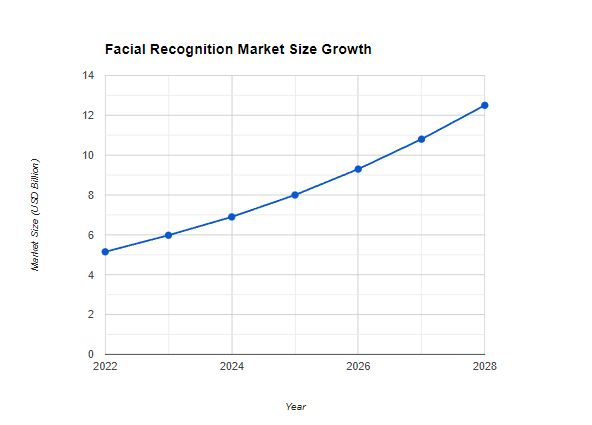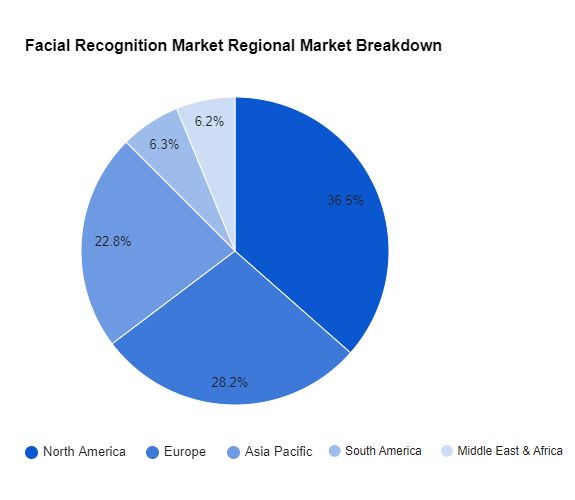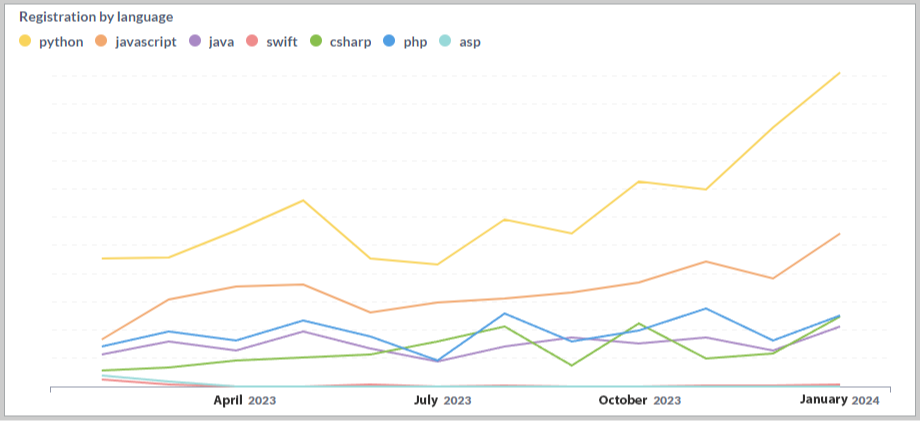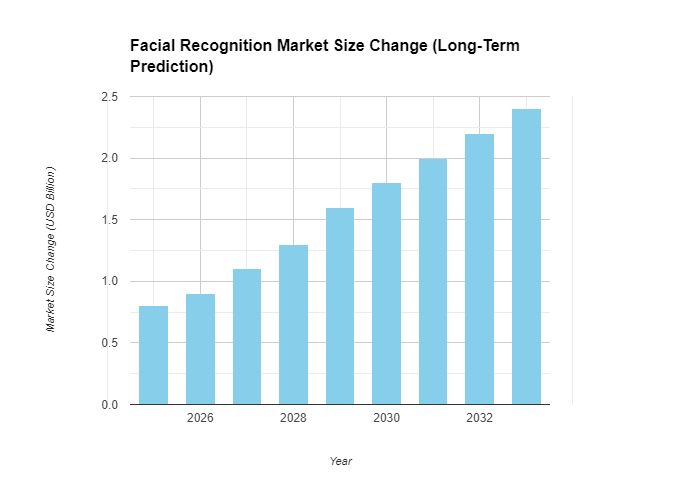and the distribution of digital products.
The Facial Recognition Industry: A Developer's Perspective
Recently, I published a post about how I built a facial recognition app. You can read it here: How I Built a Facial Recognition Application Using JavaScript and the Luxand.cloud API. Why did I choose to use this technology for my pet-project? I came across various studies on the facial recognition market and thought it was an intriguing topic that could potentially be profitable for me. In this article, I want to share some information about the facial recognition market size, growth, and forecast. This might be of interest to you if you also work with facial recognition technology.
Market Size Analysis Global Market ValueThe global facial recognition market has seen remarkable expansion over the past few years. Current estimates place the market value at approximately $4,94 billion in 2024, reflecting a compound annual growth rate (CAGR) of 16.4% over the past decade. This growth is driven by the rising demand for enhanced security measures, the integration of facial recognition with artificial intelligence (AI), and its expanding use in sectors like retail, healthcare, and law enforcement.

\ As technology continues to advance, the accuracy and reliability of facial recognition systems have significantly improved, further fueling market adoption. The market is expected to maintain a robust growth trajectory, with projections suggesting it could reach a value of $24.3 billion by 2030. This growth is not only indicative of the technology's increasing adoption but also of its potential to reshape various industries by providing efficient, non-intrusive security and identification solutions.
Regional Market Breakdown
\ The adoption and growth of facial recognition technology vary significantly across different regions, influenced by factors such as government regulations, technological infrastructure, and cultural attitudes toward privacy and surveillance.
\
- North America. As a leader in technology innovation, North America holds the largest share of the facial recognition market. The United States, in particular, has seen widespread adoption across both public and private sectors. The use of facial recognition in airports, law enforcement, and retail has contributed to the region's dominance. Moreover, favorable government initiatives and investments in AI and biometrics are expected to sustain North America's leading position in the coming years.
- Europe. The European market is growing steadily, driven by the increasing adoption of facial recognition in security, border control, and retail. However, the region's growth is moderated by stringent data protection regulations, such as the General Data Protection Regulation (GDPR). These regulations necessitate a careful balance between innovation and privacy, influencing the development and implementation of facial recognition technologies across Europe.
- Asia-Pacific. The Asia-Pacific region is emerging as a significant growth market for facial recognition. Countries like China and India are at the forefront of adopting this technology, particularly in government surveillance, public safety, and consumer electronics. China's extensive use of facial recognition for monitoring and security purposes is a major factor in the region's growth. Additionally, increasing investments in smart city projects across Asia-Pacific are expected to further boost the market.
- Rest of the World. In other regions, including Latin America, the Middle East, and Africa, the facial recognition market is still in the nascent stages but is expected to grow as technology becomes more accessible and affordable. Governments and private organizations in these regions are beginning to explore the potential of facial recognition for security and identification purposes, paving the way for future market expansion.
I recently read an article from Luxand.cloud detailing their insights on the most popular programming languages among developers in the facial recognition field. According to their findings, Python and JavaScript are currently the leading languages. This information can guide you in choosing which language to learn if you're a beginner or help you understand which language is most widely used in the sector, ensuring you can receive timely support from the community. Learn more here: Luxand.cloud Insights. Popular Programming Languages For Face Recognition
\

\
2D Facial Recognition2D facial recognition is one of the earliest and most widely used forms of the technology. It relies on analyzing two-dimensional images, typically captured by standard cameras, to identify or verify individuals. This method works by comparing key facial features—such as the distance between the eyes or the shape of the jawline—against a database of known images.
\ While 2D facial recognition is cost-effective and relatively simple to implement, it has limitations. The technology can be sensitive to changes in lighting, angle, and facial expressions, which can affect accuracy. However, its simplicity and low-cost nature make it a popular choice for applications where high precision is not critical, such as in social media tagging, basic access control systems, and mobile device authentication.
3D Facial Recognition3D facial recognition addresses many of the limitations of its 2D counterpart by incorporating depth and contour information. This technology uses advanced sensors to capture three-dimensional images of the face, allowing for a more accurate and reliable identification process. By analyzing the depth and structure of facial features, 3D systems are less affected by changes in lighting and can identify individuals even from different angles.
\ The enhanced accuracy of 3D facial recognition makes it ideal for high-security applications, such as border control, law enforcement, and secure access systems. However, this technology is generally more expensive and complex to deploy, which has historically limited its widespread adoption. Despite these challenges, the market for 3D facial recognition is growing as the cost of the technology decreases and as demand for high-precision identification increases.
Facial AnalyticsFacial analytics takes facial recognition a step further by not only identifying individuals but also interpreting various attributes and emotions based on facial expressions. This technology can analyze aspects such as age, gender, emotional state, and even health indicators like fatigue or stress.
\ Facial analytics has found a growing niche in marketing and customer service, where businesses use it to better understand customer demographics and emotional responses to products or environments. For example, retailers can use facial analytics to gauge customer reactions to displays or advertisements, allowing for more personalized and effective marketing strategies. Additionally, healthcare providers are exploring facial analytics for non-invasive patient monitoring, offering insights into a patient's emotional and physical well-being.
Hybrid and Emerging TechnologiesThe facial recognition market is also witnessing the rise of hybrid systems that combine 2D, 3D, and facial analytics into a single, more comprehensive solution. These systems aim to leverage the strengths of each technology while minimizing their respective weaknesses. For instance, combining 2D and 3D technologies can enhance accuracy in diverse environments, while integrating facial analytics can add an extra layer of insight into an individual's state.
Market Growth DriversSo why is the facial recognition market growing? This is happening for several reasons.
Increasing Demand for Enhanced SecurityIn an era where security threats are becoming more sophisticated and widespread, the demand for robust, reliable security solutions is at an all-time high. Facial recognition technology offers a powerful tool for enhancing security across various environments, from airports and border control to corporate offices and public spaces.
\ Unlike traditional security measures, facial recognition provides a non-intrusive yet highly effective way to monitor and identify individuals in real-time. This capability is particularly valuable in high-traffic areas where manual checks are impractical. The technology’s ability to quickly and accurately identify persons of interest, prevent unauthorized access, and deter potential threats has made it a vital component of modern security systems. As security concerns continue to grow globally, so does the adoption of facial recognition as a critical defense mechanism.
Technological AdvancementsThe rapid advancement of technology is another major driver behind the growth of the facial recognition market. Improvements in machine learning, artificial intelligence (AI), and imaging technologies have significantly enhanced the accuracy, speed, and reliability of facial recognition systems.
\ These advancements have reduced the error rates and increased the capability of systems to function in challenging conditions, such as poor lighting or crowded environments. For instance, modern AI-driven facial recognition systems can adapt to changes in an individual’s appearance, such as aging or different facial expressions, improving long-term accuracy. Additionally, the integration of cloud computing has made it easier to deploy facial recognition solutions at scale, allowing for seamless updates and maintenance while reducing the burden on local infrastructure.
\ As these technologies continue to evolve, they are making facial recognition more accessible, cost-effective, and versatile, paving the way for its adoption across a broader range of applications.
Growing Adoption in Various IndustriesFacial recognition technology is no longer confined to security and law enforcement; it is finding its way into a wide array of industries, each leveraging its unique capabilities for different purposes.
\ In retail, for example, facial recognition is used to personalize customer experiences, offering tailored recommendations based on shopper profiles. In the financial sector, banks and fintech companies are adopting facial recognition for secure, convenient customer authentication, helping to combat fraud and streamline user experiences. Healthcare providers are exploring its use in patient identification and monitoring, ensuring accurate, secure access to medical records.
\ The versatility of facial recognition technology means that its adoption is expanding rapidly across sectors, driving overall market growth. As more industries recognize the value of this technology in enhancing operations, improving customer experiences, and boosting security, its adoption is set to continue climbing.
Regulatory Support and Government InitiativesGovernment initiatives and regulatory support play a critical role in the adoption and growth of facial recognition technology. In many countries, governments are actively investing in facial recognition as part of their national security and public safety strategies. This is particularly evident in areas such as law enforcement, border control, and urban surveillance.
\ For example, smart city projects across the globe are increasingly incorporating facial recognition systems to enhance public safety and manage city infrastructure more efficiently. Additionally, regulatory frameworks are gradually being established to ensure the ethical use of facial recognition, addressing privacy concerns while enabling its benefits. These frameworks are essential in building public trust and ensuring that the technology is used responsibly and effectively.
Market ForecastWhat predictions do I think could be? Here they are.
Short-Term (Next 1-2 Years) Market PredictionsIn the short term, the facial recognition market is expected to maintain a strong growth rate, driven by ongoing demand for security solutions and the increasing adoption of digital technologies. Over the next one to two years, the market is likely to see a continued rise in the deployment of facial recognition systems in both public and private sectors. This growth will be fueled by the immediate need for enhanced security measures in high-risk areas such as airports, public transportation hubs, and government facilities.
\ Additionally, the short-term market will likely witness a surge in the use of facial recognition in consumer electronics. Smartphones, laptops, and other personal devices are increasingly incorporating facial recognition as a standard feature for user authentication, capitalizing on its convenience and security. The expansion of smart home devices that utilize facial recognition for personalized experiences and access control will also contribute to market growth.
\ Moreover, as businesses continue to adapt to post-pandemic realities, there will be a growing emphasis on contactless technologies, including facial recognition, to reduce physical interactions. This trend will further drive the adoption of facial recognition in areas such as retail, healthcare, and hospitality, where customer and patient safety is paramount.
Long-Term (Next 5-10 Years) Market PredictionsLooking further ahead, the facial recognition market is set to experience transformative growth over the next five to ten years. By 2030, the market is projected to reach unprecedented levels, driven by significant technological advancements and broader acceptance of the technology across various domains.
\ One of the most significant long-term trends will be the increasing integration of artificial intelligence and machine learning with facial recognition systems. These technologies will enhance the accuracy, speed, and versatility of facial recognition, enabling it to be used in more complex and sensitive environments. For example, AI-driven facial recognition will be capable of detecting subtle changes in facial features over time, improving its effectiveness in continuous monitoring and identity verification.
\ The long-term market will also see a broader application of facial recognition in emerging areas such as autonomous vehicles, where it could be used for driver identification and monitoring, and in the financial sector, where it will play a critical role in secure transactions and fraud prevention. As facial recognition technology becomes more sophisticated, its use in these and other innovative applications will expand, creating new market opportunities.

\
Key Trends and Future OpportunitiesSeveral key trends and opportunities will shape the future of the facial recognition market. One of the most important trends is the ongoing development of privacy-enhancing technologies. As concerns about data security and privacy continue to grow, there will be a significant focus on creating facial recognition systems that protect individual privacy while delivering accurate and reliable results. This will include advancements in encryption, data anonymization, and decentralized processing.
\ Another critical trend is the rise of multimodal biometric systems that combine facial recognition with other biometric modalities, such as voice recognition, fingerprint scanning, or iris recognition. These systems offer higher accuracy and security, making them ideal for use in high-stakes environments such as national security, financial services, and healthcare.
ConclusionThe facial recognition market is poised for significant expansion, underpinned by a combination of rising security needs, rapid technological advancements, and broadening applications across various industries. As the global landscape evolves, this technology is not only transforming how security and identification are managed but is also creating new opportunities in sectors ranging from retail and healthcare to financial services and smart cities.
\ In the short term, we can expect continued growth driven by the increasing demand for contactless solutions and the integration of facial recognition in consumer electronics and public safety systems. Over the longer term, the market will be shaped by innovations in AI, the development of privacy-preserving technologies, and the widespread adoption of facial recognition in emerging markets and smart city initiatives.
\ What conclusions can the developer draw from all of this? The facial recognition market will likely become an even more integral part of our everyday lives, offering enhanced security, convenience, and personalized experiences. And you can become part of this growth. It’s beneficial to get acquainted with this technology, try it out—perhaps work on a pet-project. For example, if your company starts using facial recognition technology, you’ll already be familiar with it, which could boost your career growth.
- Home
- About Us
- Write For Us / Submit Content
- Advertising And Affiliates
- Feeds And Syndication
- Contact Us
- Login
- Privacy
All Rights Reserved. Copyright , Central Coast Communications, Inc.